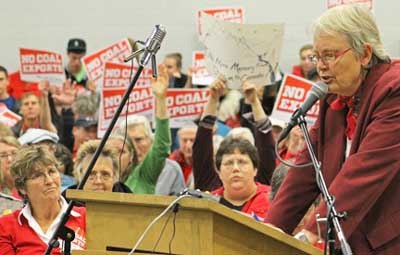The bleachers inside the gym were awash and roiling in a sea of red, the color of choice of the anti-coal crowd.
Outside the high school, the sidewalks were rimmed with placards touting the jobs and economic opportunities that an export facility built for coal would bring if permitted as proposed to nearby Cherry Point.
Battle lines were drawn early on as more than 450 people crowded into Friday Harbor High School, Saturday, to learn more about the Gateway Pacific Terminal, or to ensure that their opinion will be considered when state, federal and local officials determine “the scope” of impacts that the controversial project might have, and just how far a mandatory environmental review should go in addressing them.
An increase in shipping traffic – as many as 480 super-sized container ships carrying coal each year through the San Juans – was on the mind of most.
“These are constrained waters with many hazards,” Ken Burtness of Lopez Island, a retired ferry captain, said. A spill of coal or fuel “would be catastrophic to the San Juans,” possibly “worse than Exxon Valdez,” he added. John Brash, a retired merchant sailor, echoed Burtness’ concerns.
“We’re going to be in real trouble if a maritime disaster occurs,” Brash said.
If approved, the $650 million Gateway Terminal would be the largest bulk export facility on the West Coast, perhaps in the nation. At full capacity, it would be capable of exporting up to 54 million metric tons of coal a year from the plant that SSA Marine, which operates an export terminal at the Port of Seattle, and others worldwide, is seeking to build at Cherry Point, just north of Bellingham.
The facility, as proposed, would store coal transported by rail from Montana and Wyoming’s Powder River Basin on coal-train caravans, each more than a mile long, circulating daily through the plant. The coal would then be shipped through the Salish Sea and San Juans by cargo ships, many of which measure more then three football fields in length, to Asian markets, where it would be sold as fuel.
Critics contend the increase in shipping and rail traffic the facility would demand will produce air and noise pollution, greater traffic congestion and environmental risks, and undermine the region’s quality of life and possibly its draw as a tourist destination. Supporters point to the many economic benefits both the facility and its construction will deliver, including up to 2,000 new jobs and a boost to the bottom line of state and local governments.
 Some argue the fear of shipping accident is overblown. Michael Gallegos cited a letter from former United States Coast Guard captain Mike Moore, now an executive with Pacific Marine Shipping Association, representing owners and operators of marine terminals and shipping companies. Moore’s letter argues that “this is an incredibly large navigational area with wide, deep waterways” which has “relatively low vessel traffic congestion” and “the lowest oil spill rate in the nation when comparing to major port complexes.”
Some argue the fear of shipping accident is overblown. Michael Gallegos cited a letter from former United States Coast Guard captain Mike Moore, now an executive with Pacific Marine Shipping Association, representing owners and operators of marine terminals and shipping companies. Moore’s letter argues that “this is an incredibly large navigational area with wide, deep waterways” which has “relatively low vessel traffic congestion” and “the lowest oil spill rate in the nation when comparing to major port complexes.”
Others believe that the San Juans would be better off if the plant were built in Washington state rather than across the border in Canada.
“I would rather see a clean, well-run, state-of-the-art port in Bellingham rather than a Canadian port we have no control over,” Friday Harbor’s Greg Hertel said.
Testimony offered at Saturday’s scoping meeting in Friday Harbor, the second of seven in Washington state, adds to a growing catalog of information and commentary that officials from the Army Corps of Engineers, Washington Department of Ecology and Whatcom County will considered in determining what impacts should be addressed and where to draw geographic boundaries of a mandatory environmental impact statement. The EIS will then outline modifications, alternatives or “mitigation” measures SSA Marine would need to make in construction and operation of the facility.
SSA Marine Senior Vice President for Business Development Bob Watters provided a written statement at Saturday’s meeting. “I want San Juan islanders to know that SSA Marine wants a very thorough science-based evaluation of our project. We believe this process will help bring that about. Most important, the Gateway Pacific Terminal will meet our state’s high environmental standards.”
Watters estimates the EIS and permitting process, and the construction phase together might delay the start of operations at Gateway Pacific until 2017.
Dr. Joe Gaydos of Orcas Island-based SeaDoc Society noted the Salish Sea is home to 37 species of marine mammals, 172 species of birds and 280 species of fish, adding that one-third of the mammals and birds, and 15 percent of the fish, are listed either as “endangered” or “threatened” under federal law.
Gaydos, along with a host of local scientists, argues that the EIS must be “comprehensive, pragmatic”, and even “global”, in its scope.
For more info on the Gateway Terminal Project EIS, visit, www.ecy.wa.gov/geographic/gatewaypacific/
– Journal reporter Steve Wehrly contributed to this report.



